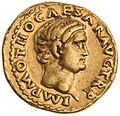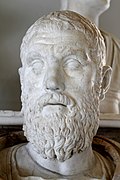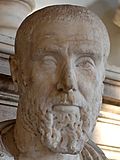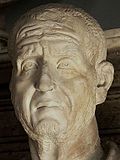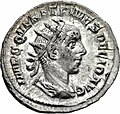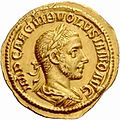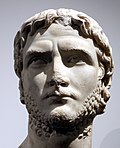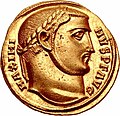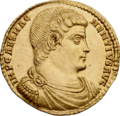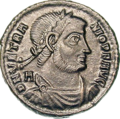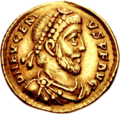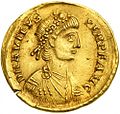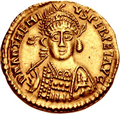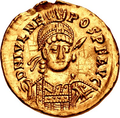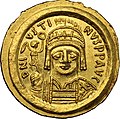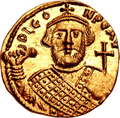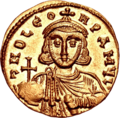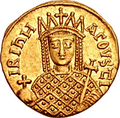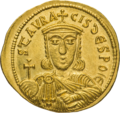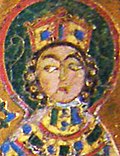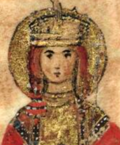Top Qs
Timeline
Chat
Perspective
List of Roman emperors
From Wikipedia, the free encyclopedia
Remove ads
The Roman emperors were the rulers of the Roman Empire from the granting of the name and title Augustus to Octavian by the Roman Senate in 27 BC onward.[1] Augustus maintained a facade of Republican rule, rejecting monarchical titles but calling himself princeps senatus (first man of the Senate) and princeps civitatis (first citizen of the state). The title of Augustus was conferred on his successors to the imperial position, and emperors gradually grew more monarchical and authoritarian.[2]
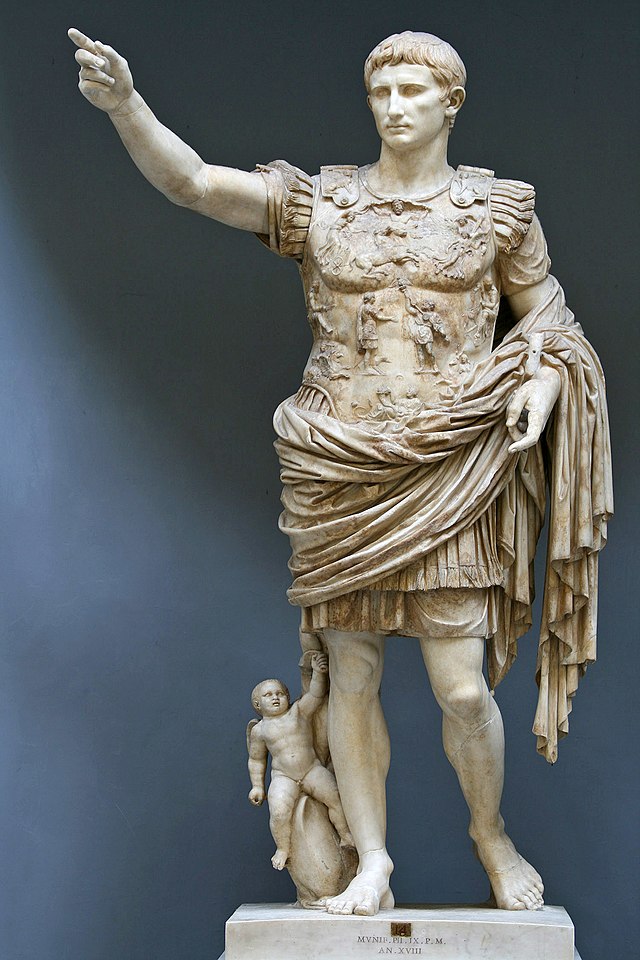
The style of government instituted by Augustus is called the Principate and continued until the late third or early fourth century.[3] The modern word "emperor" derives from the title imperator, that was granted by an army to a successful general; during the initial phase of the empire, the title was generally used only by the princeps.[4] For example, Augustus's official name was Imperator Caesar Divi Filius Augustus.[5] The territory under command of the emperor had developed under the period of the Roman Republic as it invaded and occupied much of Europe and portions of North Africa and the Middle East. Under the republic, the Senate and People of Rome authorized provincial governors, who answered only to them, to rule regions of the empire.[6] The chief magistrates of the republic were two consuls elected each year; consuls continued to be elected in the imperial period, but their authority was subservient to that of the emperor, who also controlled and determined their election.[7] Often, the emperors themselves, or close family, were selected as consul.[8]
After the Crisis of the Third Century, Diocletian increased the authority of the emperor and adopted the title dominus noster (our lord). The rise of powerful barbarian tribes along the borders of the empire, the challenge they posed to the defense of far-flung borders as well as an unstable imperial succession led Diocletian to divide the administration of the Empire geographically with a co-augustus in 286. In 330, Constantine the Great, the emperor who accepted Christianity, established a second capital in Byzantium, which was renamed Constantinople. Historians consider the Dominate period of the empire to have begun with either Diocletian or Constantine, depending on the author.[9] For most of the period from 286 to 480, there was more than one recognized senior emperor, with the division usually based on geographic regions. This division became permanent after the death of Theodosius I in 395, which historians have traditionally dated as the division between the Western Roman Empire and the Eastern Roman Empire. However, formally the Empire remained a single polity, with separate co-emperors in the separate courts.[10]
The fall of the Western Roman Empire is dated either from the de facto date of 476, when Romulus Augustulus was deposed by the Germanic Herulians led by Odoacer, or the de jure date of 480, on the death of Julius Nepos, when Eastern emperor Zeno ended recognition of a separate Western court.[11] Historians typically refer to the empire in the centuries that followed as the "Byzantine Empire", governed by the Byzantine emperors.[a] Given that "Byzantine" is a later historiographical designation and the inhabitants and emperors of the empire continually maintained Roman identity, this designation is not used universally and continues to be a subject of specialist debate.[b] Under Justinian I, in the sixth century, a large portion of the western empire was retaken, including Italy, Africa, and part of Spain.[15] Over the course of the centuries thereafter, most of the imperial territories were lost, which eventually restricted the empire to Anatolia and the Balkans.[c] The line of emperors continued until the death of Constantine XI Palaiologos at the fall of Constantinople in 1453, when the remaining territories were conquered by the Ottoman Turks led by Sultan Mehmed II.[21][d] In the aftermath of the conquest, Mehmed II proclaimed himself kayser-i Rûm ("Caesar of the Romans"),[e] thus claiming to be the new emperor,[25] a claim maintained by succeeding sultans.[26] Competing claims of succession to the Roman Empire have also been forwarded by various other states and empires, and by numerous later pretenders.[27]
Remove ads
Legitimacy
Summarize
Perspective

While the imperial government of the Roman Empire was rarely called into question during its five centuries in the west and fifteen centuries in the east, individual emperors often faced unending challenges in the form of usurpation and perpetual civil wars.[28] From the rise of Augustus, the first Roman emperor, in 27 BC to the sack of Rome in AD 455, there were over a hundred usurpations or attempted usurpations (an average of one usurpation or attempt about every four years). From the murder of Commodus in 192 until the fifth century, there was scarcely a single decade without succession conflicts and civil war. Very few emperors died of natural causes, with regicide in practical terms having become the expected end of a Roman emperor by late antiquity.[29] The distinction between a usurper and a legitimate emperor is a blurry one, given that a large number of emperors that were commonly considered legitimate began their rule as usurpers, revolting against the previous legitimate emperor.[30]
True legitimizing structures and theories were weak, or wholly absent in the Roman Empire,[29] and there were no true objective legal criteria for being acclaimed emperor beyond acceptance by the Roman army.[31] Dynastic succession was not legally formalized, but also not uncommon, with powerful rulers sometimes succeeding in passing power on to their children or other relatives. While dynastic ties could bring someone to the throne, they were not a guarantee that their rule would not be challenged.[32] With the exception of Titus (r. 79–81; son of Vespasian), no son of an emperor who ruled after the death of his father died a natural death until Constantine I in 337. Control of Rome itself and approval of the Roman Senate held some importance as legitimising factors, but were mostly symbolic. Emperors who began their careers as usurpers had often been deemed public enemies by the senate before they managed to take the city. Emperors did not need to be acclaimed or crowned in Rome itself, as demonstrated in the Year of the Four Emperors (69), when claimants were crowned by armies in the Roman provinces, and the senate's role in legitimising emperors had almost faded into insignificance by the Crisis of the Third Century (235–285). By the end of the third century, Rome's importance was mainly ideological, with several emperors and usurpers even beginning to place their court in other cities in the empire, closer to the imperial frontier.[33]
Common methods used by emperors to assert claims of legitimacy, such as proclamation by the army, blood connections (sometimes fictitious) to past emperors, wearing imperial regalia, distributing one's own coins or statues and claims to pre-eminent virtue through propaganda, were pursued just as well by many usurpers as they were by legitimate emperors.[34] There were no constitutional or legal distinctions that differentiated legitimate emperors and usurpers. In ancient Roman texts, the differences between emperors and "tyrants" (the term typically used for usurpers) is often a moral one (with the tyrants ascribed wicked behaviour) rather than a legal one. Typically, the actual distinction was whether the claimant had been victorious or not. In the Historia Augusta, an ancient Roman collection of imperial biographies, the usurper Pescennius Niger (193–194) is expressly noted to only be a tyrant because he was defeated by Septimius Severus (r. 193–211).[35] This is also followed in modern historiography, where, in the absence of constitutional criteria separating them, the main factor that distinguishes usurpers from legitimate Roman emperors is their degree of success. What makes a figure who began as a usurper into a legitimate emperor is typically either that they managed to gain the recognition from a more senior, legitimate emperor, or that they managed to defeat a more senior, legitimate emperor and seize power from them by force.[32]
List inclusion criteria
Given that a concept of constitutional legitimacy was irrelevant in the Roman Empire, and emperors were only 'legitimate' in so far as they were able to be accepted in the wider empire,[36] this list of emperors operates on a collection of inclusion criteria:
- Imperial claimants whose power across the empire became, or from the beginning was, absolute and who ruled undisputed are treated as legitimate emperors.[37] From 286 onward, when imperial power was usually divided among two colleagues in the east and west,[38] control over the respective half is sufficient even if a claimant was not recognized in the other half, such as was the case for several of the last few emperors in the west.[39]
- Imperial claimants who were proclaimed emperors by another, legitimate, senior emperor, or who were recognized by a legitimate senior emperor, are treated as legitimate emperors.[40] Many emperors ruled alongside one or various joint-emperors. However, and specially from the 4th century onwards, most of these were children who never ruled in their own right. Scholars of the later Empire always omit these rulers,[41] but the same is not always applied during the early Empire.[42] For the purposes of consistency, later senior emperors' tenures as junior co-emperors are not counted as part of their reign. The list also gives all co-emperors their own entry only up to the 4th century.
- Imperial claimants who achieved the recognition of the Roman Senate, especially in times of uncertainty and civil war, are, due to the senate's nominal role as an elective body, treated as legitimate emperors.[43] In later times, especially when emperors ruled from other cities, this criterion defaults to the possession and control of Rome itself. In the later eastern empire, possession of the capital of Constantinople was an essential element of imperial legitimacy.[44]
In the case of non-dynastic emperors after or in the middle of the rule of a dynasty, it is customary among historians to group them together with the rulers of said dynasty,[45] an approach that is followed in this list. Dynastic breaks with non-dynastic rulers are indicated with thickened horizontal lines.
Remove ads
Principate (27 BC – AD 284)
Julio-Claudian dynasty (27 BC – AD 68)
Year of the Four Emperors (68–69)
Flavian dynasty (69–96)
Nerva–Antonine dynasty (96–192)
Year of the Five Emperors (193)
- Note: The other claimants during the Year of the Five Emperors were Pescennius Niger and Clodius Albinus, generally regarded as usurpers.
Severan dynasty (193–235)
Crisis of the Third Century (235–285)
Remove ads
Dominate (284–476)
Tetrarchy (284–324)
Constantinian dynasty (306–363)
Valentinianic dynasty (364–392)
Theodosian dynasty (379–457)
Last western emperors (455–476)
Remove ads
Later Eastern emperors (457–1453)
Leonid dynasty (457–518)
Justinian dynasty (518–602)
Heraclian dynasty (610–695)
Twenty Years' Anarchy (695–717)
Isaurian (Syrian) dynasty (717–802)
Nikephorian dynasty (802–813)
Amorian dynasty (820–867)
Macedonian dynasty (867–1056)
Doukas dynasty (1059–1078)
Komnenos dynasty (1081–1185)
Angelos dynasty (1185–1204)
Laskaris dynasty (1205–1261)
- Note: Roman rule in Constantinople was interrupted with the capture and sack of the city by the crusaders in 1204, which led to the establishment of the Frankokratia. Though the crusaders created a new line of Latin emperors in the city, modern historians recognize the line of emperors of the Laskaris dynasty, reigning in Nicaea, as the legitimate Roman emperors during the struggle for Constantinople because the Nicene Empire eventually retook the city.[23] For other lines of claimant emperors, see List of Trapezuntine emperors and List of Thessalonian emperors.
Palaiologos dynasty (1259–1453)
- Note: The Empire had up to three capitals: Selymbria, Thessalonica and Constantinople.[256]
Remove ads
Other claims to the Roman imperial title
Summarize
Perspective
Remove ads
See also
- List of Roman empresses – for a list of the consorts of the Roman emperors
- Burial places of Roman emperors – for a list of the burial places of the Roman emperors
- List of Roman consuls – for a list of the consuls who held power during the Roman Republic and who continued to be appointed in imperial times
- List of Roman dictators – for a list of dictators during the Roman Republic
- List of Roman dynasties – for a list of the many dynasties that ruled the Roman Empire
- Family tree of Roman emperors – for a concise family tree of emperors and their immediate family (27 BC–518 AD)
- Family tree of Byzantine emperors – for a concise family tree of emperors and their immediate family (337–1453)
Remove ads
Notes
- The term basileus eventually replaced augustus as the official title of the emperor, although both were seen as equals already by the times of Constantine I.[12]
- The Byzantine Empire is universally recognized as the remnant, continuation or later stage of the Roman Empire. There is no universally agreed date used to separate the ancient Roman and "Byzantine" empires, with proposed dates ranging in age from 284 to 717.[13] Some authors reject the term "Byzantine" entirely.[14]
- Spain was lost in 625[16] and Africa in 698.[17] A large portion of Italy was conquered by the Lombards already under Justinian I's successor, Justin II.[18] Rome and its surroundings remained under imperial control until 756, when they became the Papal States,[19] though the last Italian holdouts were not lost until 1071 with the fall of Bari.[20] The seventh century also saw much of the empire's eastern and southern territories lost permanently to Arab Muslim conquests.[21]
- There is no generally-accepted count of Roman emperors given that different scholars sometimes include and omit different emperors (see Legitimacy). This list includes 170 emperors, 8 of whose legitimacy is disputed in scholarship (including the obscure figure of Silbannacus, whose existence and role are shrouded in mystery,[22] and the four emperors of Nicaea, who are often seen as the "legitimate" emperors during the interregnum of 1204–1261),[23] and 4 ruling empresses for a total of 174 monarchs. Also included are 35 junior co-emperors, 3 of whose legitimacy is debated, and 1 junior co-empress (Thekla). All in all, this list thus includes a total of 210 occupants of the Roman imperial office.
- This was one of the titles used for the emperors in Constantinople by Ottoman writers prior to 1453.[24]
- Entries also include the regnal name of each emperor. These generally differed from their birth name, often adopting elements from the previous emperor.[46] Augustus's full name would be "Gaius Julius Caesar Augustus" according to Roman naming conventions ("Octavian" was a nickname), but he styled himself as "Imperator Caesar Augustus", treating "Caesar" as a family name.[47] Given that "Imperator" was only a victory title, it will be omitted from the emperors' full nomenclature.
- The conventional date for the Empire's founding is 27 BC,[48] when the Senate awarded Octavian the title and name Augustus alongside one of several grants of power.[49] Ancient writers, however, give him a rule of 56 years.[48] He became de facto monarch in 31 BC, after defeating his last remaining opposition at the Battle of Actium.[50] This is a date also used by some writers.[48] Augustus himself dated his accession to legal power to 7 January 43 BC, when he first received imperium.[49] Later that year he became consul (19 August) and then triumvir (27 November) alongside Mark Antony and Lepidus. Augustus thus ruled the Roman state for exactly 56 years, but only 40 as "emperor".[49]
- The junior co-emperors marked as being of "varying ascribed status" are figures, mostly children, who are usually not counted as "true" emperors given their submissive status to the senior emperor, but are still present in some lists of rulers.[42]
- Unless otherwise noted to be some other ambiguity, the emperors marked to be of ambiguous legitimacy are those who fulfill one or more of the inclusion criteria above, but who are not universally regarded by scholars to count as legitimate. In most cases, such figures are those who held power only briefly, and/or who in times of more than one emperor held one of the capitals but never achieved the full recognition of the other emperor(s).[81][82][failed verification][83][84]
- On account of the limited surviving source material, almost all dates used here are just approximate. The chronology of the whole period is dubious and sources rarely agree on each other, in part due to the fact that many reigns overlap due to most emperors starting as rivals. For an analysis of the chronology, see Rea 1972, Peachin 1990 and Burgess 2014.
- Made caesar by his father and only referred to as augustus in a single series of coins, issued while he was besieged in Cologne in 260. Coinage issued after his death lack any title; probably because Gallienus did not want to advertise the death of a second emperor in one year.[104][105] It is unclear whether his acclamation was ever recognized (or even known) by Gallienus, but if he had survived it would surely have been recognized (like Theodosius II, who was proclaimed by the army but was accepted by Gallienus).
- The chronology of Maximian's career is disputed. Some authors argue that he was promoted to augustus without ever being caesar, as claimed by many others. Another possible date for his accession as emperor (and the first division of the Roman Empire) is 13 December 285.[117]
- Legitimately appointed as co-emperor by Licinius, though as western emperor (in opposition to Constantine I). Referred as caesar in literary sources, but called augustus in coinage. Did not actually rule anything given that Licinius did not control the west.[125]
- From the fourth century, emperors and other high-profile men of non-aristocratic birth often bore the name "Flavius", the family name of the Constantinian dynasty. Because it was often used as a status marker rather than personal name,[137] "Flavius" will generally be omitted in the following entries for simplicity.
- Distinction between nomen, praenomen and cognomen, the core elements of Roman naming conventions, began to fade away from the 3rd century onwards. Given that "new Romans" —that is, barbarians turned citizens— adopted the names of their masters, many citizens adopted the names Julius, Flavius (notable the Constantinians) and Marcus Aurelius (notable the 3rd century emperors), thus making them obsolete as surnames. As a result, most citizens of the Empire, even emperors, reverted back to single-names by the 5th century.[139]
- Although they constitutionally held the same supreme power as their senior counterpart, it is customary among scholars of the later empire to only regard those who actually ruled as emperors, omitting junior co-emperors who only exercised power nominally and never governed in their own name. Most of these co-emperors were children that barely appear in historical records.[144][145]
- There is particular confusion surrounding the name "Constantine III", as it has been applied to both a Western (Constantine) and an Eastern emperor (Heraclius Constantine). Heraclius Constantine is often enumerated as 'Constantine III',[182] but this name is also often applied to the earlier western emperor and has also been used for Heraclius Constantine's son Constans II (who actually ruled under the name 'Constantine', 'Constans' being a nickname).[183]
- Tiberius and Heraclius were crowned by their father Constans II on 2 June 659, likely as babies. Constantine tried to get rid of his brothers as soon as they came of age, but the army rioted. He initially accepted, but quickly turn against the leaders of the revolt and executed them. Then, around October 681, cut the noses of their brothers, a common Byzantine punishment that disqualified anyone from the throne.[187]
- Latin ceased being used in coin inscriptions under Leo III.[180]
- Most of miniature portraits used for the 9th to 11th centuries are not contemporary, but taken from the 12th-century Madrid Skylitzes. The portrait of Nikephoros I is taken from the Manasses Chronicle (c. 1345), while the portrait of Nikephoros II is taken from a 15th-century miniature of uncertain origin. All of these portraits are almost certainly imaginary. The 15th-century Mutinensis gr. 122 is used for some 11th-century emperors with no surviving portrait, although these are probably imaginary as well.
- Son of Christopher and grandson of Romanos I; unattested in official documents and only briefly mentioned by Michael Psellos and Joannes Zonaras. He was probably crowned as a baby but died shortly after, certainly before 927.[215]
- Emperors began to officially use family names from Constantine IX Monomachos onwards. The sole exception after Constantine IX's reign is Michael VI, whose family name (Bringas) was far less distinguished than those of the other imperial families and thus does not appear in official use.[227]
- Unattested in official documents; Leo is only called emperor in a singular letter, while his brother's status can only be deduced from the fact that he was born in the purple and that he also used the "imperial tokens".[233]
- Constantine Doukas notably served as junior co-emperor of two emperors, first his father Michael VII and then Alexios I, who briefly restored his rights. As always, this was only symbolical, as Constantine remained a minor during both tenures, having been crowned as a newborn. He died on 12 August 1094, aged around 20 years old.[237]
- The identification of this figure from Vat. Gr. 1851 as Alexios II is by Ioannis Spatharakis.[241] Other historians variously identify him as a young Andronikos IV Palaiologos[242] or Andronikos II Palaiologos.[243]
- Many of the miniature portraits used for the late Byzantine period are not contemporary, but taken from the Codex Mutinensis graecus 122, completed c. 1425 and expanded after 1453. The codex depicts almost every single Roman emperor from Augustus to Constantine XI, but only the later portraits are considerable reliable, specially those of the Palaiologoi.
- Alexios III used the name Alexios Komnenos Angelos (Ἀλέξιος Κομνηνός Ἄγγελος) prior to his accession but reigned as Alexios Komnenos, dropping his own family name in order to stress his matrilineal descent from the Komnenos dynasty.[247]
- Unattested in coins, Nicholas is called "emperor and heir" in a single document. He died soon after, less than 10 years old.[251]
- During the last years of the Empire, the territory of Thessalonica was effectively ruled as separate realm from Constantinople. Two empresses, Irene and Anna, took residence there, even having their own courts and ruling as de facto empresses regnant. Anna notably ruled in Thessalonica in opposition to John VI Kantakouzenos, who later recognized her portion of the empire.[258][259]
- Manuel, who previously had been given governorship over Thessalonica and had already been crowned co-emperor, set up an independent court and ruled there as basileus instead of despotes. Manuel ruled in opposition of his father's soft policies towards the Ottomans, waging war uppon them. However, the city eventually fell and Manuel had to flee in shame.[268]
- This depiction of John VIII is from the Magi Chapel, which was painted in 1459–1461 (about a decade after his death) by Benozzo Gozzoli. Gozzoli likely saw John in person at the Council of Florence. He also seems to have used a medal by Pisanello as a source.[270][271]
Remove ads
References
Further reading
External links
Wikiwand - on
Seamless Wikipedia browsing. On steroids.
Remove ads







